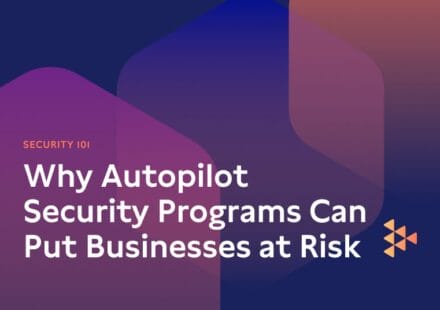We often seek out convenience in life, and it’s not really our fault – we’re wired deep down to take the path of least resistance. However, the reality is that life comes with trade-offs, and in this case, we are trading security for convenience. Automating processes is beneficial, but when done without oversight or context, it can lead to serious consequences and leave businesses open to risks. In this blog post, we’ll explore:
- Why full automation doesn’t equal security
- What you can automate securely
- What you can’t automate
- Why building security in the beginning is better
Why “Full Automation” Fails Without Context
Imagine you are taking a road trip with your friends and are relying on your GPS to guide you home. You set it to the destination address to “Home” and begin your journey. But after a while, you realize you and your friends are taking an unfamiliar and longer route – courtesy of the “Avoid Tolls” setting you forgot was automatically enabled in your GPS from a previous trip. This error in assuming you would get to your destination in a timely manner serves as a reminder that setting things on autopilot, while convenient, is not foolproof and requires regular oversight to adapt to changing conditions.
Translating this lesson to security, it becomes clear that automation tools, though powerful, cannot single-handedly ensure a secure environment. The dynamic nature of threats and the complexity of security landscapes necessitate a combination of automation, human expertise, and the latest technological defenses. Relying solely on automation can leave gaps in your security posture, potentially leading to compliance failures, vulnerabilities, and in the worst case, a loss of trust with customers and partners.
Spotlight on SOC 2: Balancing Automation & Active Management
SOC 2 serves as a prime example of a security framework that requires a nuanced approach. While certain aspects of your security program, such as policy creation, evidence collection, and compliance monitoring, can be automated for efficiency, SOC 2 also requires rigorous human-led processes like annual policy reviews, incident response planning, and vendor management. Striking that critical balance between automated systems and expert human oversight is the key to achieving comprehensive and, more importantly, adaptable and scalable security.
What Can Be Automated Safely
Automation in security can significantly enhance efficiency and accuracy, provided it is applied thoughtfully to suitable aspects of the security program. Here are some areas where automation can be safely implemented, along with examples and benefits:
Policy, Control, and Task Creation: Automation tools can streamline the development of security policies, controls, and tasks based on industry standards and best practices. For instance, automated policy generators can ensure that policies are comprehensive, up-to-date, and aligned with laws like GDPR or HIPAA.
Evidence Collection: Through integrations, automated systems can efficiently gather the required evidence for compliance audits, such as a SOC 2 audit. This process reduces manual errors and saves time by automatically compiling necessary documentation and security logs.
Security Awareness Training Reporting: Automated platforms can track completion and engagement rates of security training programs, providing insights into areas where additional training might be needed and ensuring all employees are up to date with security best practices.
Compliance and Cloud Monitoring: Continuous monitoring of cloud environments and compliance status can be automated to detect deviations from expected configurations or compliance standards. This real-time monitoring allows for the identification and remediation of vulnerabilities.
Vendor and Asset Management: Through active integrations with IT management solutions, automation can maintain up-to-date inventories of assets and vendors, assess them for risks, and manage their lifecycle, ensuring that all external partners comply with the organization’s security requirements.
The key advantage of automating these areas lies in their ability to offload repetitive, rule-based tasks from security teams, allowing them to focus on more strategic initiatives that require human intuition and judgment.
What Can’t Be Automated
While automation can handle numerous security functions, certain aspects require human expertise and intervention:
Annual Policy Review and Governance: Although automation can signal when reviews are due, the actual process of reviewing policies, assessing their relevance, and updating them to reflect new threats or regulatory changes requires human expertise and contextual understanding.
Incident Response: Automated systems can detect anomalies and potential threats, but human judgment is essential for interpreting these alerts, determining the severity of incidents, and deciding on the appropriate response.
Vulnerability Scans: While automated tools can perform vulnerability scans, the interpretation of results, prioritization of risks, and development of remediation plans benefit from human analysis.
Vendor Risk Assessment and Management: Assessing the security posture of vendors involves more than just ticking boxes; it requires a nuanced evaluation of the vendor’s practices, policies, and the potential impact of their security posture on your organization. Organizations will often even conduct personal interviews with vendors to assess their implementation of security frameworks like SOC 2 or ISO 27001.
Change Management and Segregation of Duties: Implementing changes to security practices or IT systems requires careful planning and oversight to ensure that new or updated processes do not introduce vulnerabilities. Additionally, maintaining segregation of duties to prevent fraud and errors cannot be fully automated, as it involves nuanced decisions about access controls and responsibilities.
At the end of the day, human insight is essential when interpreting data, making nuanced judgments, and adapting to evolving security landscapes. The combination of automation for efficiency and human expertise for decision-making forms the cornerstone of a robust and adaptable security program.
Start Early and Start Right with Carbide
The journey to robust security begins with a proactive approach, integrating security and privacy considerations into your tech stack and team from the start. By doing so, you ensure that your organization’s infrastructure, vendor relationships, and data management practices are designed with security at their core. This foundational approach to security not only mitigates risks but also streamlines the path to compliance with standards like SOC 2, ISO 27001, or any other security framework or regulation relevant to your industry.
Ultimately, security is not a set-it-and-forget-it affair. Automation offers significant advantages in efficiency and consistency, but the nuanced nature of security demands a blend of technology and people. Move beyond autopilot security today with Carbide – our team of security experts is ready to help you begin your security program the right way.


